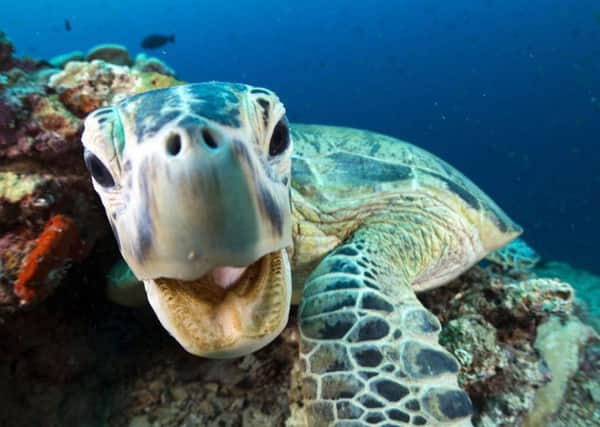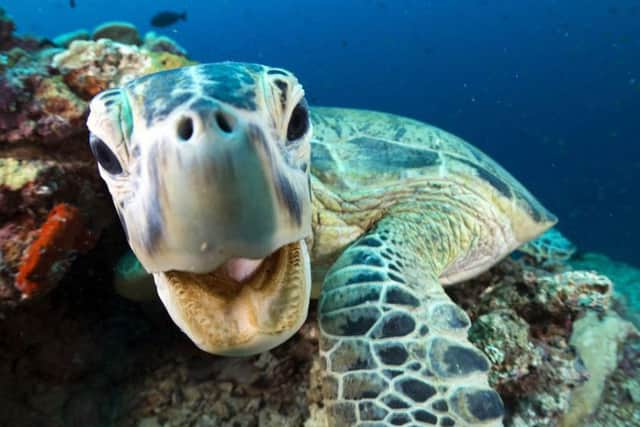10 extraordinary facts in the first episode of Blue Planet II


Sir David and his team do just that, revealing all manner of animal behaviour and peppering the show with intriguing facts about little known sea-creatures.
Advertisement
Hide AdHere are some of the most interesting facts we learn from the opening episode, which is broadcast on Sunday night.


1. Dolphins self-medicate
As dolphins surf off the coast of South Africa, Sir David muses about the mammals being “extremely intelligent”. To prove this, cameras follow the dolphins beneath the surface where they display extraordinary brain power.
The mammals rub themselves against the throngs of a mucus-covered Gorgonian sea fan that has anti-inflamatory and anti-microbial properties to protect themselves from infection.
“The dolphins’ intimate knowledge of the reef is spurring us to search for new medicines here too,” concludes Sir David.


2. Orcas can stun herring using their tales
Orcas previously starred in Frozen Planet, using wave power to break ice and unseat resting seals.
In Blue Planet II the predators hunt herring by beating their tails and releasing a shockwave that stuns the herring. The orcas can then collect their dazed prey with ease.
3. Tuskfish use tools
Advertisement
Hide AdA theme of the opening episode of Blue Planet II is the surprising intelligence of fish. A visit to the lively Great Barrier Reef delivers a fascinating insight into the behaviour of the Tuskfish.
On a daily basis the fish visit the edge of the reef and use their tusks to collect a clam, before returning to a bowl-shaped coral equipped with an anvil of sorts, which the fish then use to break open the clam.
Advertisement
Hide Ad“Some fish are much more clever than you might suppose,” insists Sir David.
4. Waves possess explosive power
It isn’t just creatures that are under the microscope in Blue Planet II – the immense power of waves are also examined. In its lifetime a large storm can release energy via waves that is the equivalent to 10,000 nuclear bombs.
5. Trevally can calculate air speed, altitude and trajectory of prey
A David Attenborough documentary wouldn’t be complete without a nerve-jangling battle of wits between predator and prey. In episode one this takes place between the monstrous trevally and a baby tern.
The trevally are capable of leaping from the water and calculating the air speed, altitude and trajectory of the tern, catching the prey in mid air, before devouring it beneath the surface.
6. Plankton are the lungs of the planet
Advertisement
Hide AdAs mobula ray feed on plankton, the microscopic lifeforms turn fluorescent, lighting up the sea, or as Sir David puts it, “the feasting rays swim through them, creating an extraordinary ballet of life and death.”
As well as their capability to deliver a spectacular light show, plankton are also vital to Earth’s oxygen supply. Combined with seaweeds and sea grasses, plankton produce as much oxygen as all the forests and grassy plains on land.
7. ‘False Killer Whales’ form friendships with dolphins
Advertisement
Hide AdIn a thrilling chase False Killer Whales (actually a type of dolphin) pursue other dolphins off the coast of New Zealand. The close relatives of the orca do not intend any harm, however.
When the two species meet they interact and bond, altering their calls. Some scientists suggest that individuals may recognise each other.
“These different species appear to be old friends,” says Sir David.
8. The Arctic is shrinking rapidly
The declining health of our planet has been a common theme of previous BBC natural world documentaries and Blue Planet II is no different. The opening episode ends with a warning of the profound impact climate change has had.
“Here (The Arctic) in the past 30 years the extent of the ice in summer has been reduced by 40%,” says Sir David. “This sudden warming, most likely a consequence of human activity, is having a profound impact on its wildlife.”
9. The Asian Sheepshead Wrasse is capable of changing sex
Along with being quite possibly the ugliest fish known to man, the Asian Sheepshead Wrasse is also capable of changing sex.
Advertisement
Hide AdWhen female wrasse reach a certain weight, their body undergoes a dramatic transformation, ceasing to create certain enzymes and instead producing male hormones. Over only a few months the wrasse transforms from female to male.
10. Blue Planet II took four years to make
The series has been four years in the making, with the various teams exploring every ocean, “seeking extraordinary stories”. If episode one is anything to go by it has been well worth the wait.
Blue Planet II gets underway on BBC One at 8pm Sunday (29 October)
This article first appeared on our sister site, iNews.